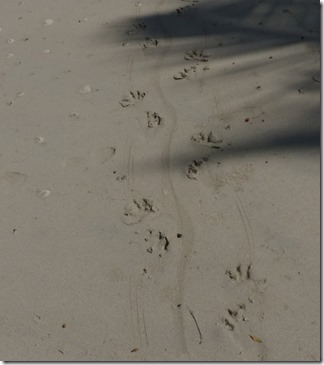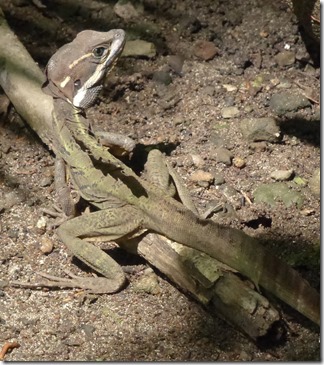On December 27th in the morning we sailed about 5 miles to the nearby Isla Rancheria. Here we found a small paradise on Earth. This island used to be privately owned and when the owner passed away it was acquired by the Smithsonian Society, one of the most important and renowned biological research association in the world.
We anchored in a beautiful bay in the eastern part of the island where we could snorkel among the most diverse population of fishes and turtles. We were amazed how confident and fearless they were, getting close to us at less than a meter of distance. Some of them appeared quite curious and amazed themselves.
December 27th – Snorkeling at Isla Rancheria
December 27th – Snorkeling at Isla Rancheria
After enjoying the marine life, we landed with the dinghy on the beach and we discovered a trail crossing the forest that shortly led us to an abandoned air strip with a colonial house at one end. There were a couple of guardians who explained us that this was the base camp for Smithsonian researchers specialized in different fields, such as marine biology, primatology, entomology, etc. Nevertheless, they allowed us to explore the island, including the long, wonderful beach facing Coiba.
December 28th – Bay on the east side of Isla Rancheria
December 28th – Smithsonian Base Camp
December 28th – View of Islas Cocos from Isla Rancheria
December 28th – Beach on the south side of Isla Rancheria
December 28th – Beach on the south side of Isla Rancheria
The footprints of crocodile below were not there when we first walked to the beach!
After a couple of days, we sailed to Granito de Oro, an islet east of Coiba, that is a paradise for scuba diving and snorkeling. Here we admired even more fishes and turtles than in Isla Rancheria, including a nurse shark (known to be non-aggressive toward human beings). One turtle, while swimming to the surface to take a breath, went just in front of the mask of Gemma. We kept going back snorkeling several time and it was always a unique and unforgettable experience!
December 29th – Isla Granito de Oro
December 29th – People come to Isla Granito de Oro even by helicopter!
December 29th – Snorkeling at Isla Granito de Oro
The morning after our arrival at Isla Granito de Oro, the Park rangers came to our boat demanding us to pay what we thought to be an outrageous fee – 20$ per person + 60$ for the boat/day. When we asked to pay a more reasonable amount, they nicely replied they would need to check with their manager, and left. As after several hours they did not return, we decided to leave and sail to the next spot, the site of the old prisons. In fact, Isla Coiba was a penal colony until the end of the 20th century, where the life condition for prisoners must have been so terrible that sometimes they tried to escape despite crocodiles, sharks and the distance from the mainland. This is also the reason why these islands are still uncontaminated and present such a variety of fauna and flora. We spent the night anchored in front of the old buildings and early in the morning we took the dinghy to visit the area. We discovered that nowadays this is a site for the Aeronaval (the Panamanian coast guard) as a few armed soldiers kindly but firmly warned us to leave immediately Bahia Damas as the entire bay is off-limits.
December 30th – Former penal colony at Bahia Damas
We pulled the anchor and chose as the next destination Isla Jicaron, south of Coiba. We anchored in a nice bay in the north of the island, and decided to go ashore with the dinghy. This was too quick of a decision, as when we approached the beach we had to go through an adventurous landing due to the breaking waves. The payoff was a show setup by a flock of pelicans which were fishing with spectacular dives into the water.
The next day, the last day of 2018, we sailed to Isla Jicarita where we spent New Year’s Eve at the most rolling anchorage we experienced in the whole year – we can say we danced all night! It was definitely a very peculiar way to start 2019… For those that are curious, our dinner consisted of lentils and a “fake fish” (canned tuna, boiled potatoes, capers, and our own made mayonnaise) accompanied by a more than decent Italian Prosecco bought in Panama.
On January 1st, we moved toward more calm waters at Ensenada Hermosa on the west side of Coiba. Here we spent two days enjoying great snorkeling and a beautiful beach where we could spot a capuchin monkey making his noisy display on a branch just above us. From the beach you could walk up a small stream of fresh, clear water; it was great to take a bath in a lovely, natural cold pool. However, the most impressive close encounter was with a bright yellow fish, about 2 cm long, that followed us for the whole time we snorkeled, and left only when we reached the boat and got out of the water. We wondered what was the meaning of such “affiliative” behavior!
January 2nd – Gemma and our temporary pet, the tiny yellow fish
On January 3rd, while we were having breakfast, we heard some knocks on the hull: it was again a boat of Park rangers who informed us that we should either go to the Park station to pay the registration fees or leave immediately the island. Since this was really our last spot we meant to visit, we left this beautiful marine park, setting sails back to Isla Secas.
January 3rd – A sula taking a ride on our bimini sailing to Isla Secas
Coiba National Park (85 nm)
On December 27th in the morning we sailed about 5 miles to the nearby Isla Rancheria. Here we found a small paradise on Earth. This island used to be privately owned and when the owner passed away it was acquired by the Smithsonian Society, one of the most important and renowned biological research association in the world.
We anchored in a beautiful bay in the eastern part of the island where we could snorkel among the most diverse population of fishes and turtles. We were amazed how confident and fearless they were, getting close to us at less than a meter of distance. Some of them appeared quite curious and amazed themselves.
December 27th – Snorkeling at Isla Rancheria
December 27th – Snorkeling at Isla Rancheria
After enjoying the marine life, we landed with the dinghy on the beach and we discovered a trail crossing the forest that shortly led us to an abandoned air strip with a colonial house at one end. There were a couple of guardians who explained us that this was the base camp for Smithsonian researchers specialized in different fields, such as marine biology, primatology, entomology, etc. Nevertheless, they allowed us to explore the island, including the long, wonderful beach facing Coiba.
December 28th – Bay on the east side of Isla Rancheria
December 28th – Smithsonian Base Camp
December 28th – View of Islas Cocos from Isla Rancheria
December 28th – Beach on the south side of Isla Rancheria
December 28th – Beach on the south side of Isla Rancheria
The footprints of crocodile below were not there when we first walked to the beach!

After a couple of days, we sailed to Granito de Oro, an islet east of Coiba, that is a paradise for scuba diving and snorkeling. Here we admired even more fishes and turtles than in Isla Rancheria, including a nurse shark (known to be non-aggressive toward human beings). One turtle, while swimming to the surface to take a breath, went just in front of the mask of Gemma. We kept going back snorkeling several time and it was always a unique and unforgettable experience!
December 29th – Isla Granito de Oro
December 29th – People come to Isla Granito de Oro even by helicopter!
December 29th – Snorkeling at Isla Granito de Oro
The morning after our arrival at Isla Granito de Oro, the Park rangers came to our boat demanding us to pay what we thought to be an outrageous fee – 20$ per person + 60$ for the boat/day. When we asked to pay a more reasonable amount, they nicely replied they would need to check with their manager, and left. As after several hours they did not return, we decided to leave and sail to the next spot, the site of the old prisons. In fact, Isla Coiba was a penal colony until the end of the 20th century, where the life condition for prisoners must have been so terrible that sometimes they tried to escape despite crocodiles, sharks and the distance from the mainland. This is also the reason why these islands are still uncontaminated and present such a variety of fauna and flora. We spent the night anchored in front of the old buildings and early in the morning we took the dinghy to visit the area. We discovered that nowadays this is a site for the Aeronaval (the Panamanian coast guard) as a few armed soldiers kindly but firmly warned us to leave immediately Bahia Damas as the entire bay is off-limits.
December 30th – Former penal colony at Bahia Damas
We pulled the anchor and chose as the next destination Isla Jicaron, south of Coiba. We anchored in a nice bay in the north of the island, and decided to go ashore with the dinghy. This was too quick of a decision, as when we approached the beach we had to go through an adventurous landing due to the breaking waves. The payoff was a show setup by a flock of pelicans which were fishing with spectacular dives into the water.
The next day, the last day of 2018, we sailed to Isla Jicarita where we spent New Year’s Eve at the most rolling anchorage we experienced in the whole year – we can say we danced all night! It was definitely a very peculiar way to start 2019… For those that are curious, our dinner consisted of lentils and a “fake fish” (canned tuna, boiled potatoes, capers, and our own made mayonnaise) accompanied by a more than decent Italian Prosecco bought in Panama.
On January 1st, we moved toward more calm waters at Ensenada Hermosa on the west side of Coiba. Here we spent two days enjoying great snorkeling and a beautiful beach where we could spot a capuchin monkey making his noisy display on a branch just above us. From the beach you could walk up a small stream of fresh, clear water; it was great to take a bath in a lovely, natural cold pool. However, the most impressive close encounter was with a bright yellow fish, about 2 cm long, that followed us for the whole time we snorkeled, and left only when we reached the boat and got out of the water. We wondered what was the meaning of such “affiliative” behavior!
January 2nd – Gemma and our temporary pet, the tiny yellow fish
On January 3rd, while we were having breakfast, we heard some knocks on the hull: it was again a boat of Park rangers who informed us that we should either go to the Park station to pay the registration fees or leave immediately the island. Since this was really our last spot we meant to visit, we left this beautiful marine park, setting sails back to Isla Secas.
January 3rd – A sula taking a ride on our bimini sailing to Isla Secas